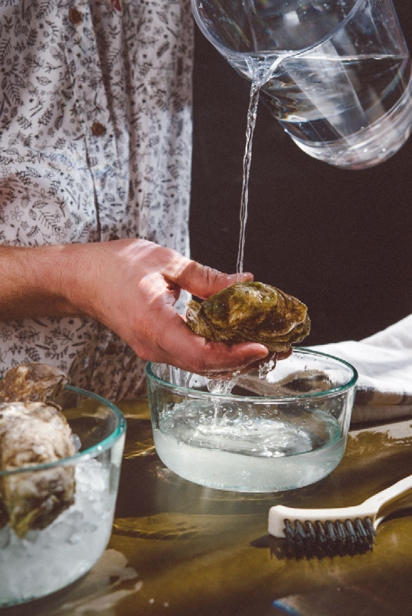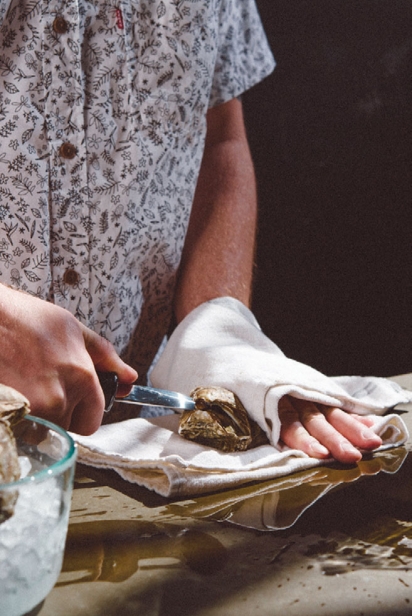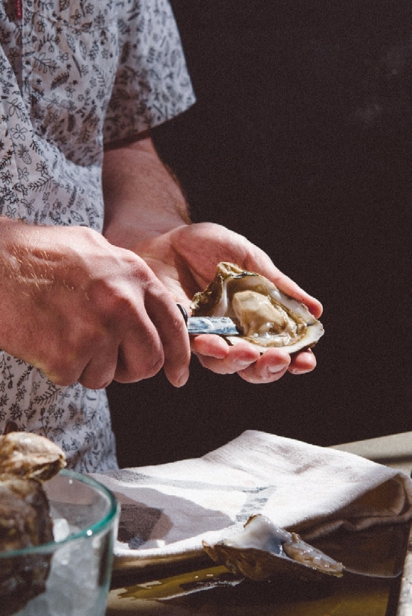Oyster Shucking
The French have a word, ‘terroir,’ that refers to the soil that a crop is grown in. It’s generally used when describing wine: how the dirt and air and rain of a particular plot of land influences the grapes that eventually become your favorite excellently-aged bottle of Bordeaux.
Other than that, I know only a handful of other French words, and most of those are also related to food and drink. I don’t know if they have a similar word that describes the water, I often think of ‘terroir’ when eating seafood, especially oysters.
Shellfish, like oysters, act as filters in the ocean, sucking up all the flavors of their waters. They sift water through their gills, looking for nutritive plankton, and absorb all the qualities of their environment.
When you eat one, you taste everything from the salinity, temperature, and mineral content of the water they were plucked out of. Even factors like the strength of the tides can alter the size and shape of an oyster.
Every single one has its own unique taste, which is wholly derived from the place it came from. Many of the well-known East Coast oysters like Blue Points or Wellfleets get their signature sharp brininess from the chilly and salty waters they come from. Pacific Northwest oysters like Kumamoto’s or Fanny Bays can be plump and creamy with clean vegetal notes.
Each time you slurp an oyster, you’re not just enjoying a delicious and nutritious little bivalve—you’re experiencing a place in the world, taking a trip to a particular cove or bay where someone wearing waders is pulling a rack of seaweed-covered shellfish out of the water. You’re breathing in the brisk, salty air of a certain body of water.
Learning to open them is the next step in connecting with oysters. It’s a useful skill, and at least a good trick to show off the next time you’re invited to a dinner party. You just need a few things to get started:
-one dozen oysters (for practice)
-clean, thick kitchen towel
-oyster knife
Buying an oyster knife is crucial. You need a specialized knife that has a very short blade with a rounded tip. They are usually not very expensive. Do not try to use a kitchen knife or a screwdriver and another utensil, as you may end up hurting yourself. Oysters are tasty, but not worth getting stitches over.
First, you will want to clean the oysters. Rinse them under cold water and scrub them with a firm-bristled brush. You want to clean them of all the dirt and grit they have brought with them from the ocean. Inspect them to make sure they are all tightly closed and intact. If an oyster has already opened, throw it away. It is either dead, or could be dying. Don’t ever take a chance on eating questionable shellfish.
There are three parts to the oyster’s shell to consider. There is the rounded part, called the cup, which we will think of as the bottom of the oyster. The lid is the flat section of shell on top. These two pieces of shell meet in the hinge, which is the pointy end.
Fold your towel in half and place the oyster cup-side-down onto one end of it, with the hinge facing you. Wrap the rest of the towel around your non-shucking hand, and place it on top of the lid. The towel is there to both keep the oyster in place, and to protect your hand in case the knife slips. Even though your oyster knife shouldn’t be too sharp, it could still puncture you, and a nice thick towel will almost always save your skin (literally).
Work the tip of the knife into the hinge. You are trying to work it in well enough that you can pop the top shell off. When the knife seems to be in the hinge well enough, rotate the blade in a clockwise or counter-clockwise motion. This is the trickiest part, and what requires the most practice. You can also try popping the blade upwards. You might accidently chip or break the oyster—don’t get frustrated. If you break one, grab another and keep trying. This is why you bought a dozen of them. If the tip of the knife gets muddy or dirty, wipe it on the towel. This will prevent extra grit from getting inside the oyster.
When the lid pops open, do your happy dance, but keep the oyster steady, as you don’t want to spill any of its tasty juices, or ‘liquor’ as it’s called. Run the edge of your knife between the opening of the shells and scrape it against the top of the lid to disconnect the little muscle attached.
Now that you’ve opened your first oyster, inspect it. If there are any fragments of the shell inside, use the tip of your knife to remove them. The meat should be plump and the liquor should be plentiful and clean. Give the oyster a niff. If it looks dried up or has a foul odor, discard it. Again: don’t ever take a chance with questionable shellfish.
There is one more muscle to disconnect on the bottom shell. Scrape the knife along the inside of the cup, and voila (another French word)! The oyster is shucked and ready to eat. Serve with a squeeze of lemon, fresh grated horseradish, maybe your favorite sauce. My favorite way: naked and unadorned, leaving all the terroir of the sea on display.









